Financial Accounting: A Report on Liquidation of Australian Companies
VerifiedAdded on 2023/04/22
|10
|3211
|111
Report
AI Summary
This report provides a financial accounting analysis of the liquidation of several Australian companies, including Aluminium Boats Australia, HIH Insurance, and Stellar Homes. It details the background of each company, the reasons for their respective collapses, and the corporate governance and ethical issues violated, particularly in relation to APES 110 Code of Ethics for Professional Accountants. The report further examines the role of liquidity in these collapses and the specific types of liquidation processes applied. Ultimately, the report offers a conclusion and suggestions based on the analysis, highlighting key factors contributing to the financial downfall of these entities and emphasizing the importance of ethical conduct and sound financial management.
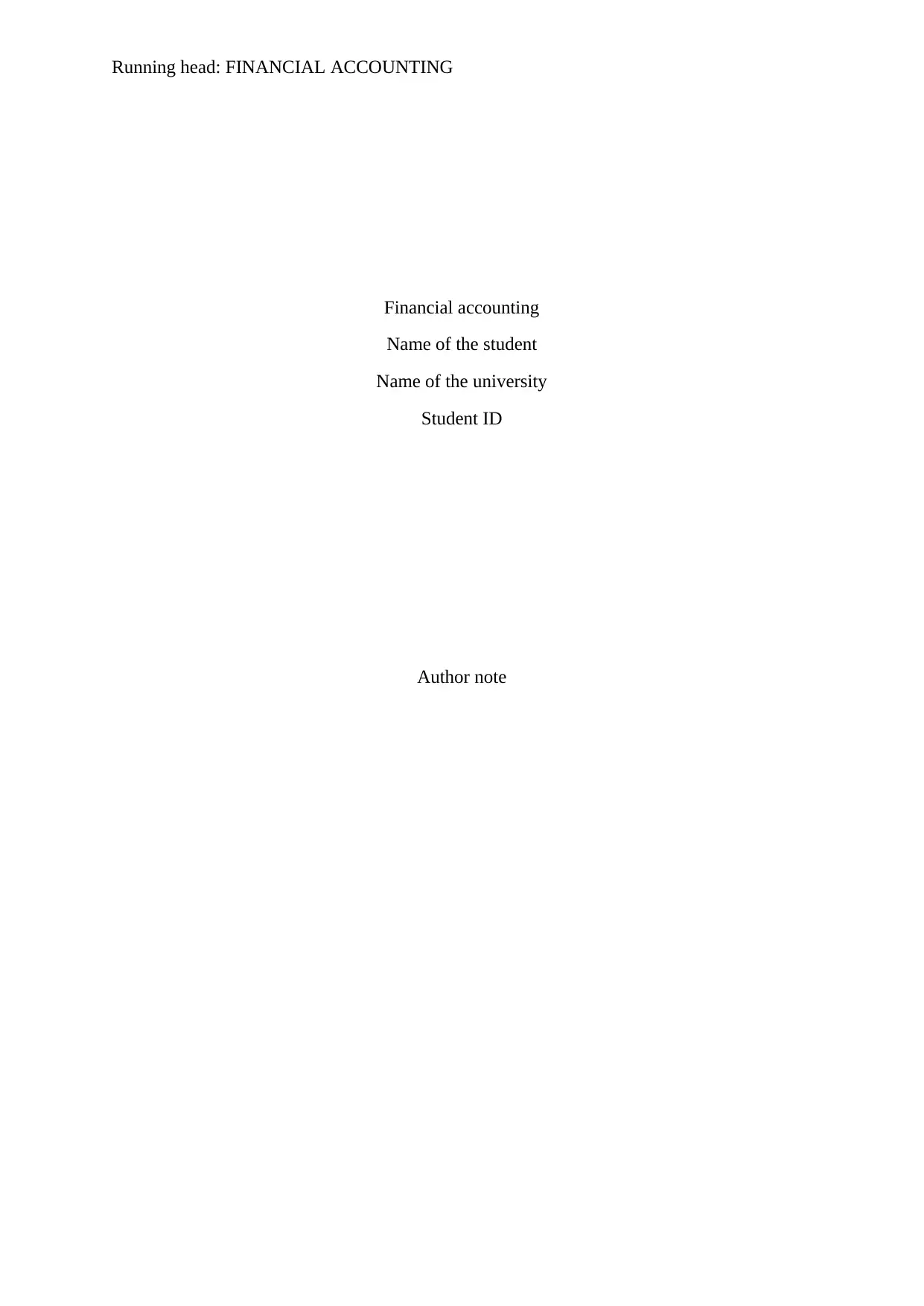
Running head: FINANCIAL ACCOUNTING
Financial accounting
Name of the student
Name of the university
Student ID
Author note
Financial accounting
Name of the student
Name of the university
Student ID
Author note
Paraphrase This Document
Need a fresh take? Get an instant paraphrase of this document with our AI Paraphraser
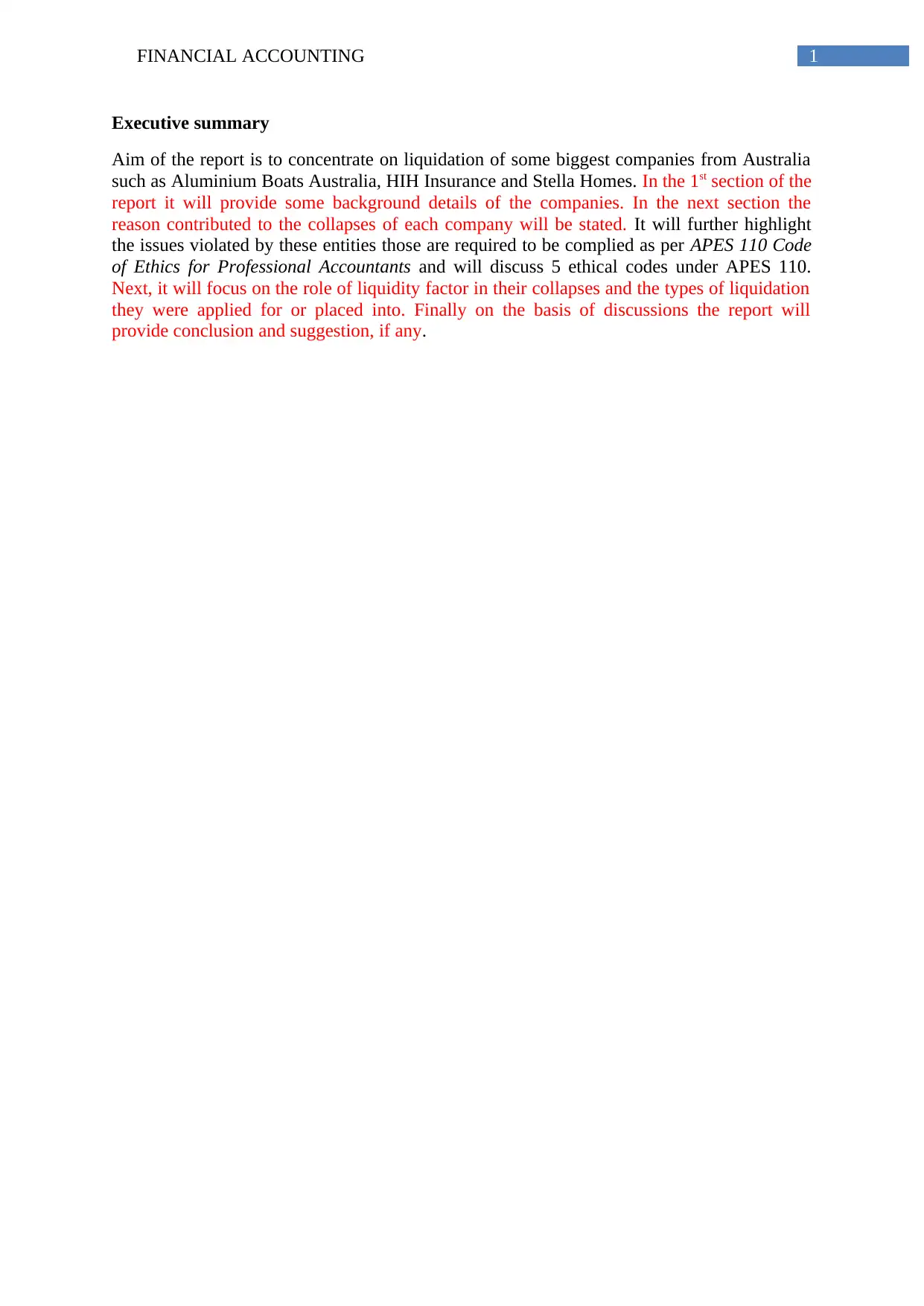
1FINANCIAL ACCOUNTING
Executive summary
Aim of the report is to concentrate on liquidation of some biggest companies from Australia
such as Aluminium Boats Australia, HIH Insurance and Stella Homes. In the 1st section of the
report it will provide some background details of the companies. In the next section the
reason contributed to the collapses of each company will be stated. It will further highlight
the issues violated by these entities those are required to be complied as per APES 110 Code
of Ethics for Professional Accountants and will discuss 5 ethical codes under APES 110.
Next, it will focus on the role of liquidity factor in their collapses and the types of liquidation
they were applied for or placed into. Finally on the basis of discussions the report will
provide conclusion and suggestion, if any.
Executive summary
Aim of the report is to concentrate on liquidation of some biggest companies from Australia
such as Aluminium Boats Australia, HIH Insurance and Stella Homes. In the 1st section of the
report it will provide some background details of the companies. In the next section the
reason contributed to the collapses of each company will be stated. It will further highlight
the issues violated by these entities those are required to be complied as per APES 110 Code
of Ethics for Professional Accountants and will discuss 5 ethical codes under APES 110.
Next, it will focus on the role of liquidity factor in their collapses and the types of liquidation
they were applied for or placed into. Finally on the basis of discussions the report will
provide conclusion and suggestion, if any.
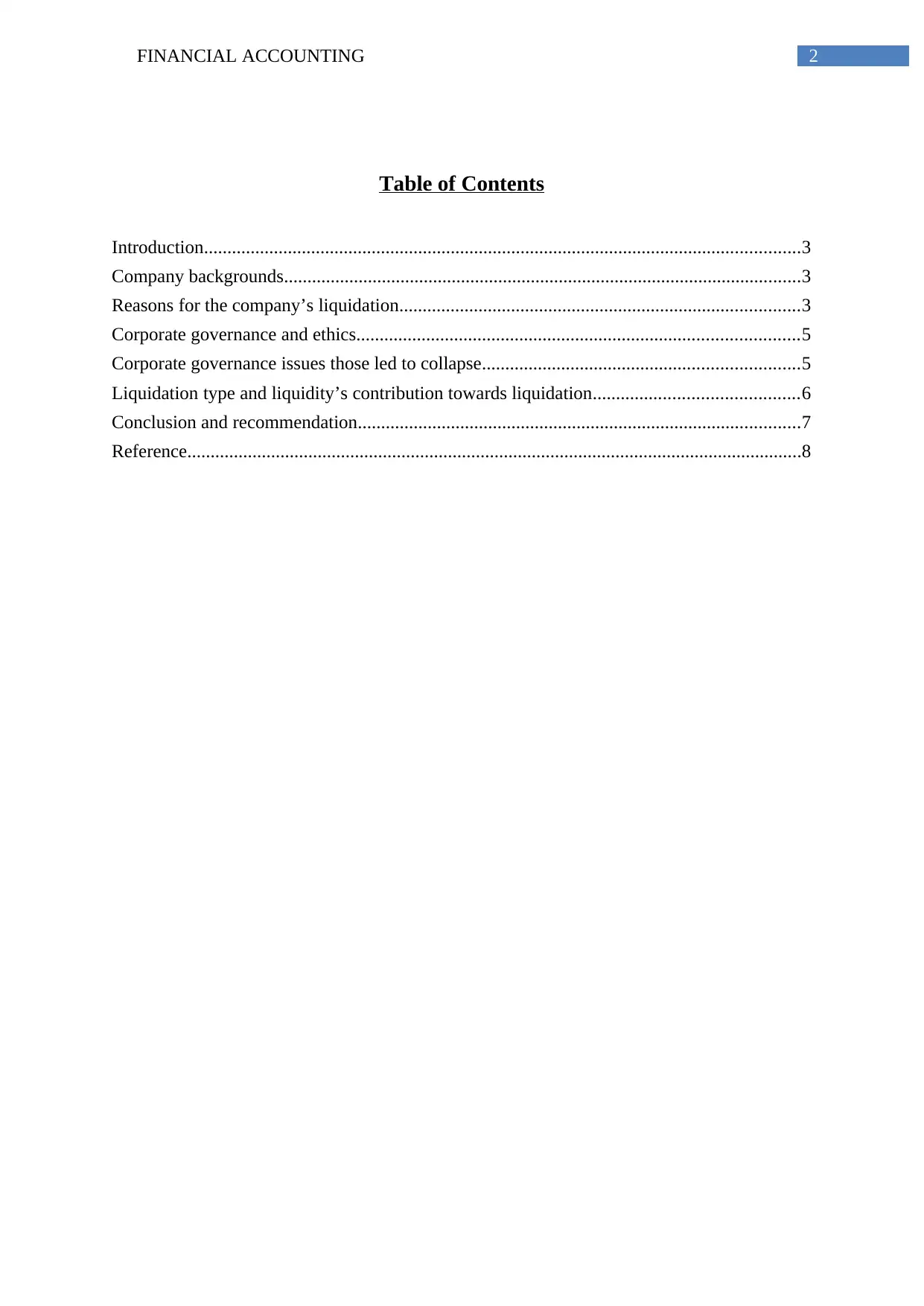
2FINANCIAL ACCOUNTING
Table of Contents
Introduction................................................................................................................................3
Company backgrounds...............................................................................................................3
Reasons for the company’s liquidation......................................................................................3
Corporate governance and ethics...............................................................................................5
Corporate governance issues those led to collapse....................................................................5
Liquidation type and liquidity’s contribution towards liquidation............................................6
Conclusion and recommendation...............................................................................................7
Reference....................................................................................................................................8
Table of Contents
Introduction................................................................................................................................3
Company backgrounds...............................................................................................................3
Reasons for the company’s liquidation......................................................................................3
Corporate governance and ethics...............................................................................................5
Corporate governance issues those led to collapse....................................................................5
Liquidation type and liquidity’s contribution towards liquidation............................................6
Conclusion and recommendation...............................................................................................7
Reference....................................................................................................................................8
⊘ This is a preview!⊘
Do you want full access?
Subscribe today to unlock all pages.

Trusted by 1+ million students worldwide
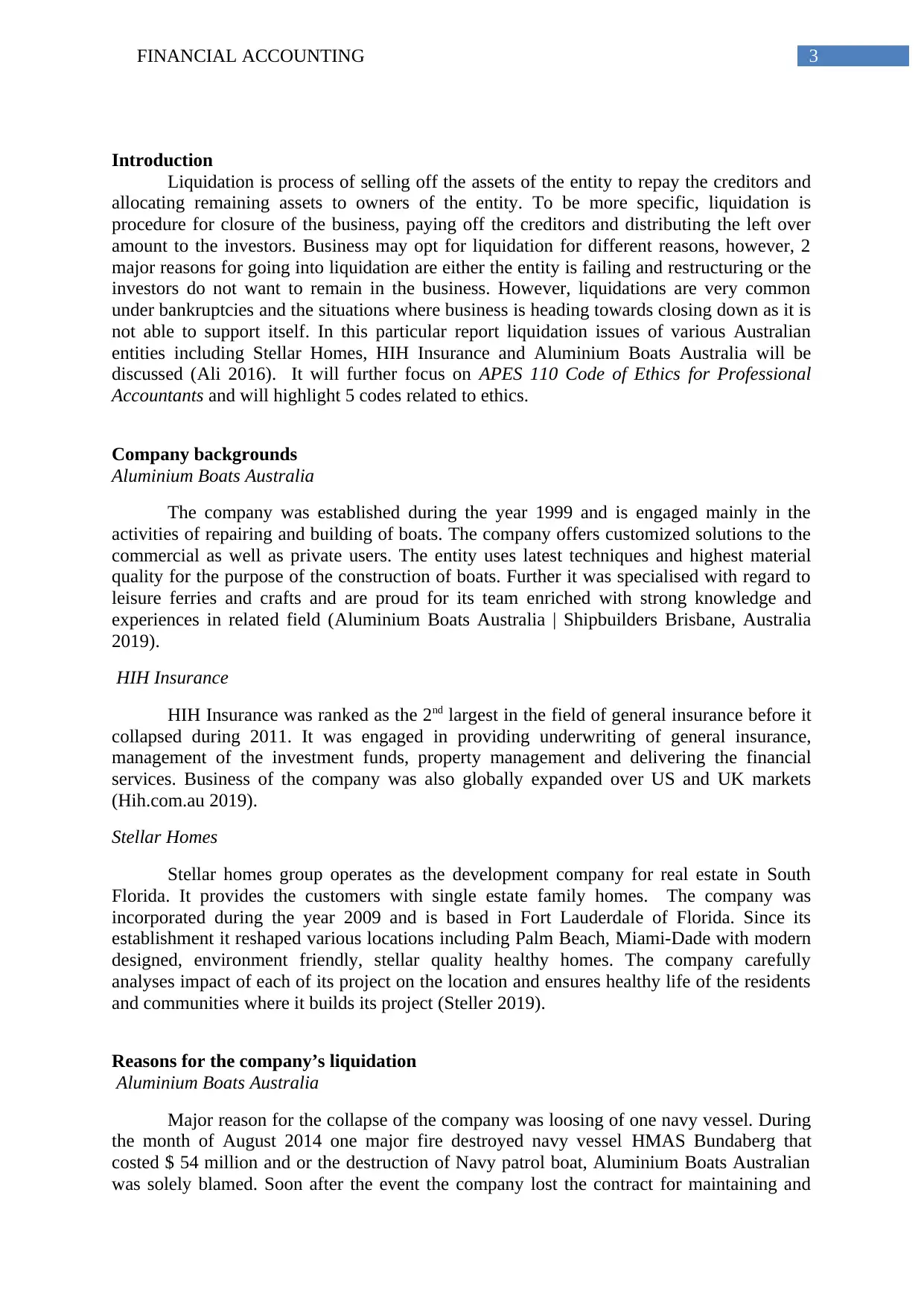
3FINANCIAL ACCOUNTING
Introduction
Liquidation is process of selling off the assets of the entity to repay the creditors and
allocating remaining assets to owners of the entity. To be more specific, liquidation is
procedure for closure of the business, paying off the creditors and distributing the left over
amount to the investors. Business may opt for liquidation for different reasons, however, 2
major reasons for going into liquidation are either the entity is failing and restructuring or the
investors do not want to remain in the business. However, liquidations are very common
under bankruptcies and the situations where business is heading towards closing down as it is
not able to support itself. In this particular report liquidation issues of various Australian
entities including Stellar Homes, HIH Insurance and Aluminium Boats Australia will be
discussed (Ali 2016). It will further focus on APES 110 Code of Ethics for Professional
Accountants and will highlight 5 codes related to ethics.
Company backgrounds
Aluminium Boats Australia
The company was established during the year 1999 and is engaged mainly in the
activities of repairing and building of boats. The company offers customized solutions to the
commercial as well as private users. The entity uses latest techniques and highest material
quality for the purpose of the construction of boats. Further it was specialised with regard to
leisure ferries and crafts and are proud for its team enriched with strong knowledge and
experiences in related field (Aluminium Boats Australia | Shipbuilders Brisbane, Australia
2019).
HIH Insurance
HIH Insurance was ranked as the 2nd largest in the field of general insurance before it
collapsed during 2011. It was engaged in providing underwriting of general insurance,
management of the investment funds, property management and delivering the financial
services. Business of the company was also globally expanded over US and UK markets
(Hih.com.au 2019).
Stellar Homes
Stellar homes group operates as the development company for real estate in South
Florida. It provides the customers with single estate family homes. The company was
incorporated during the year 2009 and is based in Fort Lauderdale of Florida. Since its
establishment it reshaped various locations including Palm Beach, Miami-Dade with modern
designed, environment friendly, stellar quality healthy homes. The company carefully
analyses impact of each of its project on the location and ensures healthy life of the residents
and communities where it builds its project (Steller 2019).
Reasons for the company’s liquidation
Aluminium Boats Australia
Major reason for the collapse of the company was loosing of one navy vessel. During
the month of August 2014 one major fire destroyed navy vessel HMAS Bundaberg that
costed $ 54 million and or the destruction of Navy patrol boat, Aluminium Boats Australian
was solely blamed. Soon after the event the company lost the contract for maintaining and
Introduction
Liquidation is process of selling off the assets of the entity to repay the creditors and
allocating remaining assets to owners of the entity. To be more specific, liquidation is
procedure for closure of the business, paying off the creditors and distributing the left over
amount to the investors. Business may opt for liquidation for different reasons, however, 2
major reasons for going into liquidation are either the entity is failing and restructuring or the
investors do not want to remain in the business. However, liquidations are very common
under bankruptcies and the situations where business is heading towards closing down as it is
not able to support itself. In this particular report liquidation issues of various Australian
entities including Stellar Homes, HIH Insurance and Aluminium Boats Australia will be
discussed (Ali 2016). It will further focus on APES 110 Code of Ethics for Professional
Accountants and will highlight 5 codes related to ethics.
Company backgrounds
Aluminium Boats Australia
The company was established during the year 1999 and is engaged mainly in the
activities of repairing and building of boats. The company offers customized solutions to the
commercial as well as private users. The entity uses latest techniques and highest material
quality for the purpose of the construction of boats. Further it was specialised with regard to
leisure ferries and crafts and are proud for its team enriched with strong knowledge and
experiences in related field (Aluminium Boats Australia | Shipbuilders Brisbane, Australia
2019).
HIH Insurance
HIH Insurance was ranked as the 2nd largest in the field of general insurance before it
collapsed during 2011. It was engaged in providing underwriting of general insurance,
management of the investment funds, property management and delivering the financial
services. Business of the company was also globally expanded over US and UK markets
(Hih.com.au 2019).
Stellar Homes
Stellar homes group operates as the development company for real estate in South
Florida. It provides the customers with single estate family homes. The company was
incorporated during the year 2009 and is based in Fort Lauderdale of Florida. Since its
establishment it reshaped various locations including Palm Beach, Miami-Dade with modern
designed, environment friendly, stellar quality healthy homes. The company carefully
analyses impact of each of its project on the location and ensures healthy life of the residents
and communities where it builds its project (Steller 2019).
Reasons for the company’s liquidation
Aluminium Boats Australia
Major reason for the collapse of the company was loosing of one navy vessel. During
the month of August 2014 one major fire destroyed navy vessel HMAS Bundaberg that
costed $ 54 million and or the destruction of Navy patrol boat, Aluminium Boats Australian
was solely blamed. Soon after the event the company lost the contract for maintaining and
Paraphrase This Document
Need a fresh take? Get an instant paraphrase of this document with our AI Paraphraser
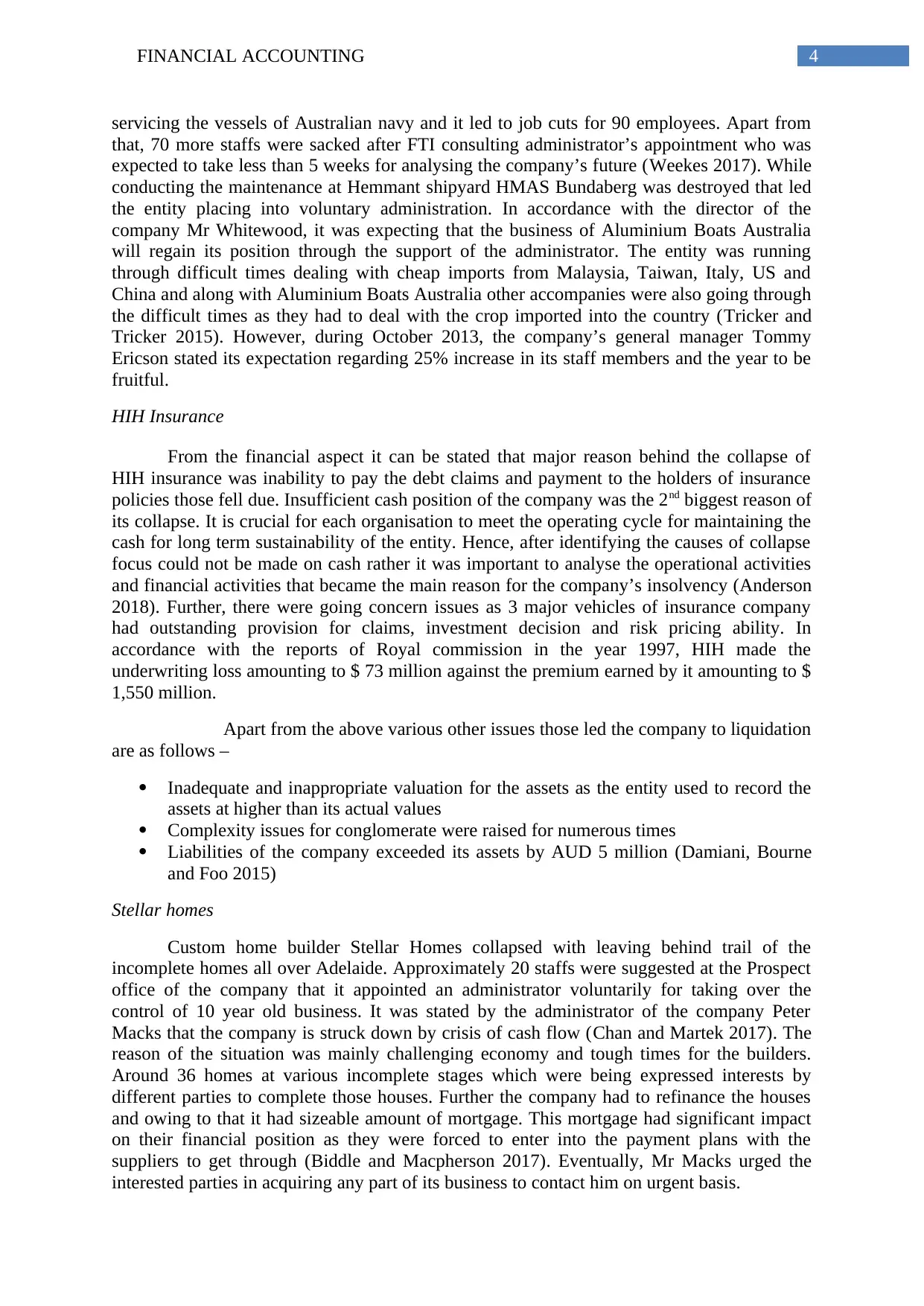
4FINANCIAL ACCOUNTING
servicing the vessels of Australian navy and it led to job cuts for 90 employees. Apart from
that, 70 more staffs were sacked after FTI consulting administrator’s appointment who was
expected to take less than 5 weeks for analysing the company’s future (Weekes 2017). While
conducting the maintenance at Hemmant shipyard HMAS Bundaberg was destroyed that led
the entity placing into voluntary administration. In accordance with the director of the
company Mr Whitewood, it was expecting that the business of Aluminium Boats Australia
will regain its position through the support of the administrator. The entity was running
through difficult times dealing with cheap imports from Malaysia, Taiwan, Italy, US and
China and along with Aluminium Boats Australia other accompanies were also going through
the difficult times as they had to deal with the crop imported into the country (Tricker and
Tricker 2015). However, during October 2013, the company’s general manager Tommy
Ericson stated its expectation regarding 25% increase in its staff members and the year to be
fruitful.
HIH Insurance
From the financial aspect it can be stated that major reason behind the collapse of
HIH insurance was inability to pay the debt claims and payment to the holders of insurance
policies those fell due. Insufficient cash position of the company was the 2nd biggest reason of
its collapse. It is crucial for each organisation to meet the operating cycle for maintaining the
cash for long term sustainability of the entity. Hence, after identifying the causes of collapse
focus could not be made on cash rather it was important to analyse the operational activities
and financial activities that became the main reason for the company’s insolvency (Anderson
2018). Further, there were going concern issues as 3 major vehicles of insurance company
had outstanding provision for claims, investment decision and risk pricing ability. In
accordance with the reports of Royal commission in the year 1997, HIH made the
underwriting loss amounting to $ 73 million against the premium earned by it amounting to $
1,550 million.
Apart from the above various other issues those led the company to liquidation
are as follows –
Inadequate and inappropriate valuation for the assets as the entity used to record the
assets at higher than its actual values
Complexity issues for conglomerate were raised for numerous times
Liabilities of the company exceeded its assets by AUD 5 million (Damiani, Bourne
and Foo 2015)
Stellar homes
Custom home builder Stellar Homes collapsed with leaving behind trail of the
incomplete homes all over Adelaide. Approximately 20 staffs were suggested at the Prospect
office of the company that it appointed an administrator voluntarily for taking over the
control of 10 year old business. It was stated by the administrator of the company Peter
Macks that the company is struck down by crisis of cash flow (Chan and Martek 2017). The
reason of the situation was mainly challenging economy and tough times for the builders.
Around 36 homes at various incomplete stages which were being expressed interests by
different parties to complete those houses. Further the company had to refinance the houses
and owing to that it had sizeable amount of mortgage. This mortgage had significant impact
on their financial position as they were forced to enter into the payment plans with the
suppliers to get through (Biddle and Macpherson 2017). Eventually, Mr Macks urged the
interested parties in acquiring any part of its business to contact him on urgent basis.
servicing the vessels of Australian navy and it led to job cuts for 90 employees. Apart from
that, 70 more staffs were sacked after FTI consulting administrator’s appointment who was
expected to take less than 5 weeks for analysing the company’s future (Weekes 2017). While
conducting the maintenance at Hemmant shipyard HMAS Bundaberg was destroyed that led
the entity placing into voluntary administration. In accordance with the director of the
company Mr Whitewood, it was expecting that the business of Aluminium Boats Australia
will regain its position through the support of the administrator. The entity was running
through difficult times dealing with cheap imports from Malaysia, Taiwan, Italy, US and
China and along with Aluminium Boats Australia other accompanies were also going through
the difficult times as they had to deal with the crop imported into the country (Tricker and
Tricker 2015). However, during October 2013, the company’s general manager Tommy
Ericson stated its expectation regarding 25% increase in its staff members and the year to be
fruitful.
HIH Insurance
From the financial aspect it can be stated that major reason behind the collapse of
HIH insurance was inability to pay the debt claims and payment to the holders of insurance
policies those fell due. Insufficient cash position of the company was the 2nd biggest reason of
its collapse. It is crucial for each organisation to meet the operating cycle for maintaining the
cash for long term sustainability of the entity. Hence, after identifying the causes of collapse
focus could not be made on cash rather it was important to analyse the operational activities
and financial activities that became the main reason for the company’s insolvency (Anderson
2018). Further, there were going concern issues as 3 major vehicles of insurance company
had outstanding provision for claims, investment decision and risk pricing ability. In
accordance with the reports of Royal commission in the year 1997, HIH made the
underwriting loss amounting to $ 73 million against the premium earned by it amounting to $
1,550 million.
Apart from the above various other issues those led the company to liquidation
are as follows –
Inadequate and inappropriate valuation for the assets as the entity used to record the
assets at higher than its actual values
Complexity issues for conglomerate were raised for numerous times
Liabilities of the company exceeded its assets by AUD 5 million (Damiani, Bourne
and Foo 2015)
Stellar homes
Custom home builder Stellar Homes collapsed with leaving behind trail of the
incomplete homes all over Adelaide. Approximately 20 staffs were suggested at the Prospect
office of the company that it appointed an administrator voluntarily for taking over the
control of 10 year old business. It was stated by the administrator of the company Peter
Macks that the company is struck down by crisis of cash flow (Chan and Martek 2017). The
reason of the situation was mainly challenging economy and tough times for the builders.
Around 36 homes at various incomplete stages which were being expressed interests by
different parties to complete those houses. Further the company had to refinance the houses
and owing to that it had sizeable amount of mortgage. This mortgage had significant impact
on their financial position as they were forced to enter into the payment plans with the
suppliers to get through (Biddle and Macpherson 2017). Eventually, Mr Macks urged the
interested parties in acquiring any part of its business to contact him on urgent basis.
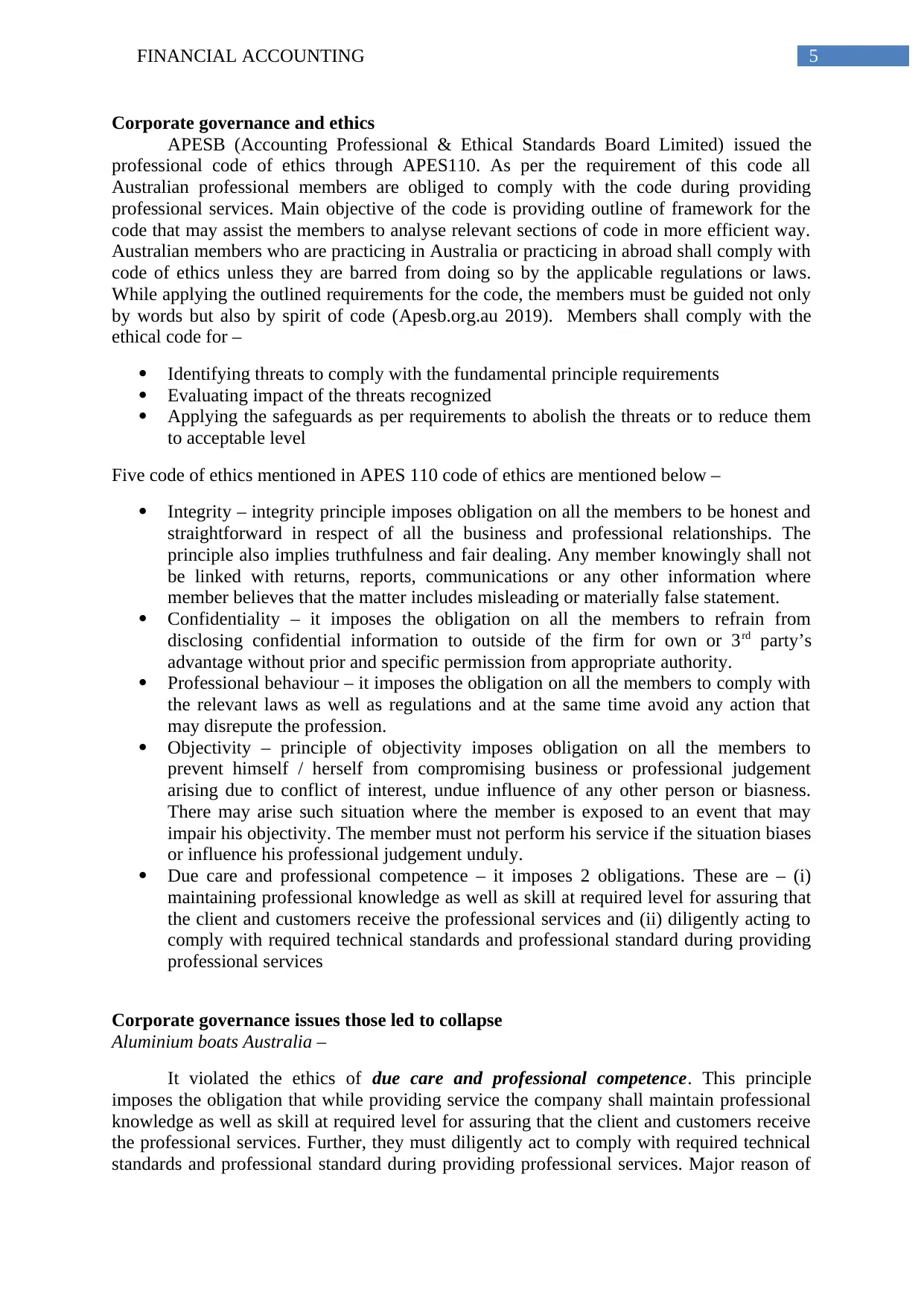
5FINANCIAL ACCOUNTING
Corporate governance and ethics
APESB (Accounting Professional & Ethical Standards Board Limited) issued the
professional code of ethics through APES110. As per the requirement of this code all
Australian professional members are obliged to comply with the code during providing
professional services. Main objective of the code is providing outline of framework for the
code that may assist the members to analyse relevant sections of code in more efficient way.
Australian members who are practicing in Australia or practicing in abroad shall comply with
code of ethics unless they are barred from doing so by the applicable regulations or laws.
While applying the outlined requirements for the code, the members must be guided not only
by words but also by spirit of code (Apesb.org.au 2019). Members shall comply with the
ethical code for –
Identifying threats to comply with the fundamental principle requirements
Evaluating impact of the threats recognized
Applying the safeguards as per requirements to abolish the threats or to reduce them
to acceptable level
Five code of ethics mentioned in APES 110 code of ethics are mentioned below –
Integrity – integrity principle imposes obligation on all the members to be honest and
straightforward in respect of all the business and professional relationships. The
principle also implies truthfulness and fair dealing. Any member knowingly shall not
be linked with returns, reports, communications or any other information where
member believes that the matter includes misleading or materially false statement.
Confidentiality – it imposes the obligation on all the members to refrain from
disclosing confidential information to outside of the firm for own or 3rd party’s
advantage without prior and specific permission from appropriate authority.
Professional behaviour – it imposes the obligation on all the members to comply with
the relevant laws as well as regulations and at the same time avoid any action that
may disrepute the profession.
Objectivity – principle of objectivity imposes obligation on all the members to
prevent himself / herself from compromising business or professional judgement
arising due to conflict of interest, undue influence of any other person or biasness.
There may arise such situation where the member is exposed to an event that may
impair his objectivity. The member must not perform his service if the situation biases
or influence his professional judgement unduly.
Due care and professional competence – it imposes 2 obligations. These are – (i)
maintaining professional knowledge as well as skill at required level for assuring that
the client and customers receive the professional services and (ii) diligently acting to
comply with required technical standards and professional standard during providing
professional services
Corporate governance issues those led to collapse
Aluminium boats Australia –
It violated the ethics of due care and professional competence. This principle
imposes the obligation that while providing service the company shall maintain professional
knowledge as well as skill at required level for assuring that the client and customers receive
the professional services. Further, they must diligently act to comply with required technical
standards and professional standard during providing professional services. Major reason of
Corporate governance and ethics
APESB (Accounting Professional & Ethical Standards Board Limited) issued the
professional code of ethics through APES110. As per the requirement of this code all
Australian professional members are obliged to comply with the code during providing
professional services. Main objective of the code is providing outline of framework for the
code that may assist the members to analyse relevant sections of code in more efficient way.
Australian members who are practicing in Australia or practicing in abroad shall comply with
code of ethics unless they are barred from doing so by the applicable regulations or laws.
While applying the outlined requirements for the code, the members must be guided not only
by words but also by spirit of code (Apesb.org.au 2019). Members shall comply with the
ethical code for –
Identifying threats to comply with the fundamental principle requirements
Evaluating impact of the threats recognized
Applying the safeguards as per requirements to abolish the threats or to reduce them
to acceptable level
Five code of ethics mentioned in APES 110 code of ethics are mentioned below –
Integrity – integrity principle imposes obligation on all the members to be honest and
straightforward in respect of all the business and professional relationships. The
principle also implies truthfulness and fair dealing. Any member knowingly shall not
be linked with returns, reports, communications or any other information where
member believes that the matter includes misleading or materially false statement.
Confidentiality – it imposes the obligation on all the members to refrain from
disclosing confidential information to outside of the firm for own or 3rd party’s
advantage without prior and specific permission from appropriate authority.
Professional behaviour – it imposes the obligation on all the members to comply with
the relevant laws as well as regulations and at the same time avoid any action that
may disrepute the profession.
Objectivity – principle of objectivity imposes obligation on all the members to
prevent himself / herself from compromising business or professional judgement
arising due to conflict of interest, undue influence of any other person or biasness.
There may arise such situation where the member is exposed to an event that may
impair his objectivity. The member must not perform his service if the situation biases
or influence his professional judgement unduly.
Due care and professional competence – it imposes 2 obligations. These are – (i)
maintaining professional knowledge as well as skill at required level for assuring that
the client and customers receive the professional services and (ii) diligently acting to
comply with required technical standards and professional standard during providing
professional services
Corporate governance issues those led to collapse
Aluminium boats Australia –
It violated the ethics of due care and professional competence. This principle
imposes the obligation that while providing service the company shall maintain professional
knowledge as well as skill at required level for assuring that the client and customers receive
the professional services. Further, they must diligently act to comply with required technical
standards and professional standard during providing professional services. Major reason of
⊘ This is a preview!⊘
Do you want full access?
Subscribe today to unlock all pages.

Trusted by 1+ million students worldwide
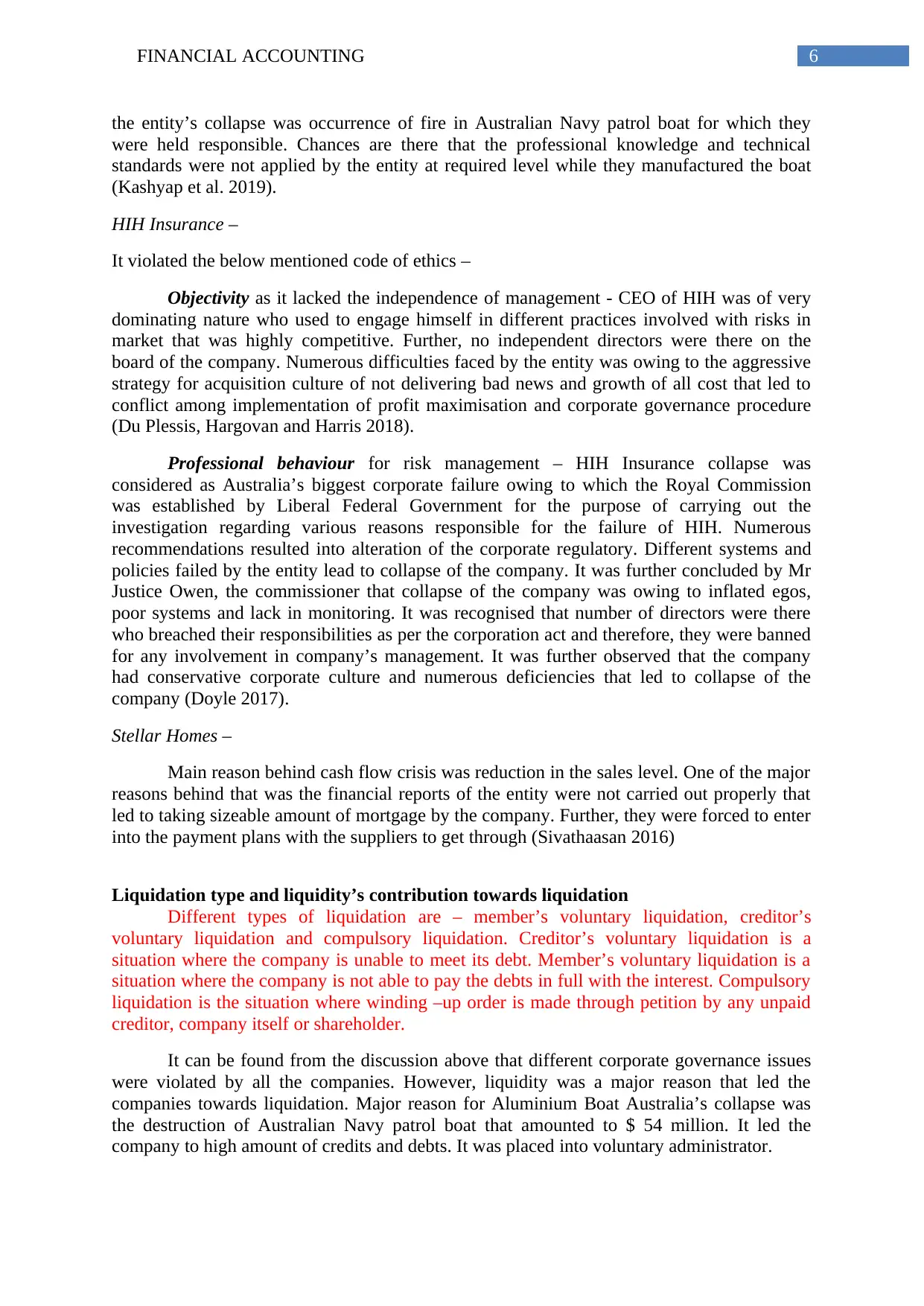
6FINANCIAL ACCOUNTING
the entity’s collapse was occurrence of fire in Australian Navy patrol boat for which they
were held responsible. Chances are there that the professional knowledge and technical
standards were not applied by the entity at required level while they manufactured the boat
(Kashyap et al. 2019).
HIH Insurance –
It violated the below mentioned code of ethics –
Objectivity as it lacked the independence of management - CEO of HIH was of very
dominating nature who used to engage himself in different practices involved with risks in
market that was highly competitive. Further, no independent directors were there on the
board of the company. Numerous difficulties faced by the entity was owing to the aggressive
strategy for acquisition culture of not delivering bad news and growth of all cost that led to
conflict among implementation of profit maximisation and corporate governance procedure
(Du Plessis, Hargovan and Harris 2018).
Professional behaviour for risk management – HIH Insurance collapse was
considered as Australia’s biggest corporate failure owing to which the Royal Commission
was established by Liberal Federal Government for the purpose of carrying out the
investigation regarding various reasons responsible for the failure of HIH. Numerous
recommendations resulted into alteration of the corporate regulatory. Different systems and
policies failed by the entity lead to collapse of the company. It was further concluded by Mr
Justice Owen, the commissioner that collapse of the company was owing to inflated egos,
poor systems and lack in monitoring. It was recognised that number of directors were there
who breached their responsibilities as per the corporation act and therefore, they were banned
for any involvement in company’s management. It was further observed that the company
had conservative corporate culture and numerous deficiencies that led to collapse of the
company (Doyle 2017).
Stellar Homes –
Main reason behind cash flow crisis was reduction in the sales level. One of the major
reasons behind that was the financial reports of the entity were not carried out properly that
led to taking sizeable amount of mortgage by the company. Further, they were forced to enter
into the payment plans with the suppliers to get through (Sivathaasan 2016)
Liquidation type and liquidity’s contribution towards liquidation
Different types of liquidation are – member’s voluntary liquidation, creditor’s
voluntary liquidation and compulsory liquidation. Creditor’s voluntary liquidation is a
situation where the company is unable to meet its debt. Member’s voluntary liquidation is a
situation where the company is not able to pay the debts in full with the interest. Compulsory
liquidation is the situation where winding –up order is made through petition by any unpaid
creditor, company itself or shareholder.
It can be found from the discussion above that different corporate governance issues
were violated by all the companies. However, liquidity was a major reason that led the
companies towards liquidation. Major reason for Aluminium Boat Australia’s collapse was
the destruction of Australian Navy patrol boat that amounted to $ 54 million. It led the
company to high amount of credits and debts. It was placed into voluntary administrator.
the entity’s collapse was occurrence of fire in Australian Navy patrol boat for which they
were held responsible. Chances are there that the professional knowledge and technical
standards were not applied by the entity at required level while they manufactured the boat
(Kashyap et al. 2019).
HIH Insurance –
It violated the below mentioned code of ethics –
Objectivity as it lacked the independence of management - CEO of HIH was of very
dominating nature who used to engage himself in different practices involved with risks in
market that was highly competitive. Further, no independent directors were there on the
board of the company. Numerous difficulties faced by the entity was owing to the aggressive
strategy for acquisition culture of not delivering bad news and growth of all cost that led to
conflict among implementation of profit maximisation and corporate governance procedure
(Du Plessis, Hargovan and Harris 2018).
Professional behaviour for risk management – HIH Insurance collapse was
considered as Australia’s biggest corporate failure owing to which the Royal Commission
was established by Liberal Federal Government for the purpose of carrying out the
investigation regarding various reasons responsible for the failure of HIH. Numerous
recommendations resulted into alteration of the corporate regulatory. Different systems and
policies failed by the entity lead to collapse of the company. It was further concluded by Mr
Justice Owen, the commissioner that collapse of the company was owing to inflated egos,
poor systems and lack in monitoring. It was recognised that number of directors were there
who breached their responsibilities as per the corporation act and therefore, they were banned
for any involvement in company’s management. It was further observed that the company
had conservative corporate culture and numerous deficiencies that led to collapse of the
company (Doyle 2017).
Stellar Homes –
Main reason behind cash flow crisis was reduction in the sales level. One of the major
reasons behind that was the financial reports of the entity were not carried out properly that
led to taking sizeable amount of mortgage by the company. Further, they were forced to enter
into the payment plans with the suppliers to get through (Sivathaasan 2016)
Liquidation type and liquidity’s contribution towards liquidation
Different types of liquidation are – member’s voluntary liquidation, creditor’s
voluntary liquidation and compulsory liquidation. Creditor’s voluntary liquidation is a
situation where the company is unable to meet its debt. Member’s voluntary liquidation is a
situation where the company is not able to pay the debts in full with the interest. Compulsory
liquidation is the situation where winding –up order is made through petition by any unpaid
creditor, company itself or shareholder.
It can be found from the discussion above that different corporate governance issues
were violated by all the companies. However, liquidity was a major reason that led the
companies towards liquidation. Major reason for Aluminium Boat Australia’s collapse was
the destruction of Australian Navy patrol boat that amounted to $ 54 million. It led the
company to high amount of credits and debts. It was placed into voluntary administrator.
Paraphrase This Document
Need a fresh take? Get an instant paraphrase of this document with our AI Paraphraser
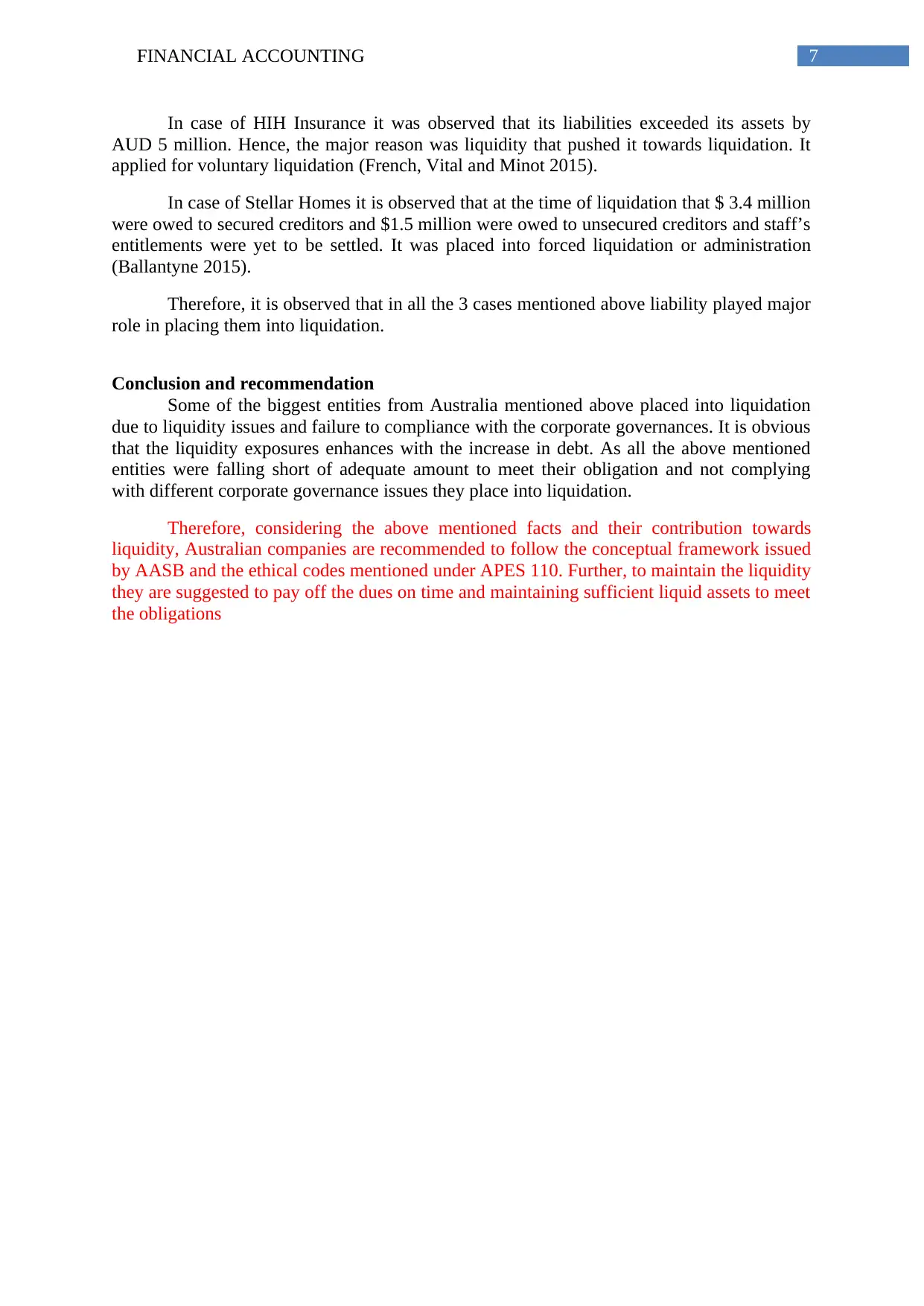
7FINANCIAL ACCOUNTING
In case of HIH Insurance it was observed that its liabilities exceeded its assets by
AUD 5 million. Hence, the major reason was liquidity that pushed it towards liquidation. It
applied for voluntary liquidation (French, Vital and Minot 2015).
In case of Stellar Homes it is observed that at the time of liquidation that $ 3.4 million
were owed to secured creditors and $1.5 million were owed to unsecured creditors and staff’s
entitlements were yet to be settled. It was placed into forced liquidation or administration
(Ballantyne 2015).
Therefore, it is observed that in all the 3 cases mentioned above liability played major
role in placing them into liquidation.
Conclusion and recommendation
Some of the biggest entities from Australia mentioned above placed into liquidation
due to liquidity issues and failure to compliance with the corporate governances. It is obvious
that the liquidity exposures enhances with the increase in debt. As all the above mentioned
entities were falling short of adequate amount to meet their obligation and not complying
with different corporate governance issues they place into liquidation.
Therefore, considering the above mentioned facts and their contribution towards
liquidity, Australian companies are recommended to follow the conceptual framework issued
by AASB and the ethical codes mentioned under APES 110. Further, to maintain the liquidity
they are suggested to pay off the dues on time and maintaining sufficient liquid assets to meet
the obligations
In case of HIH Insurance it was observed that its liabilities exceeded its assets by
AUD 5 million. Hence, the major reason was liquidity that pushed it towards liquidation. It
applied for voluntary liquidation (French, Vital and Minot 2015).
In case of Stellar Homes it is observed that at the time of liquidation that $ 3.4 million
were owed to secured creditors and $1.5 million were owed to unsecured creditors and staff’s
entitlements were yet to be settled. It was placed into forced liquidation or administration
(Ballantyne 2015).
Therefore, it is observed that in all the 3 cases mentioned above liability played major
role in placing them into liquidation.
Conclusion and recommendation
Some of the biggest entities from Australia mentioned above placed into liquidation
due to liquidity issues and failure to compliance with the corporate governances. It is obvious
that the liquidity exposures enhances with the increase in debt. As all the above mentioned
entities were falling short of adequate amount to meet their obligation and not complying
with different corporate governance issues they place into liquidation.
Therefore, considering the above mentioned facts and their contribution towards
liquidity, Australian companies are recommended to follow the conceptual framework issued
by AASB and the ethical codes mentioned under APES 110. Further, to maintain the liquidity
they are suggested to pay off the dues on time and maintaining sufficient liquid assets to meet
the obligations
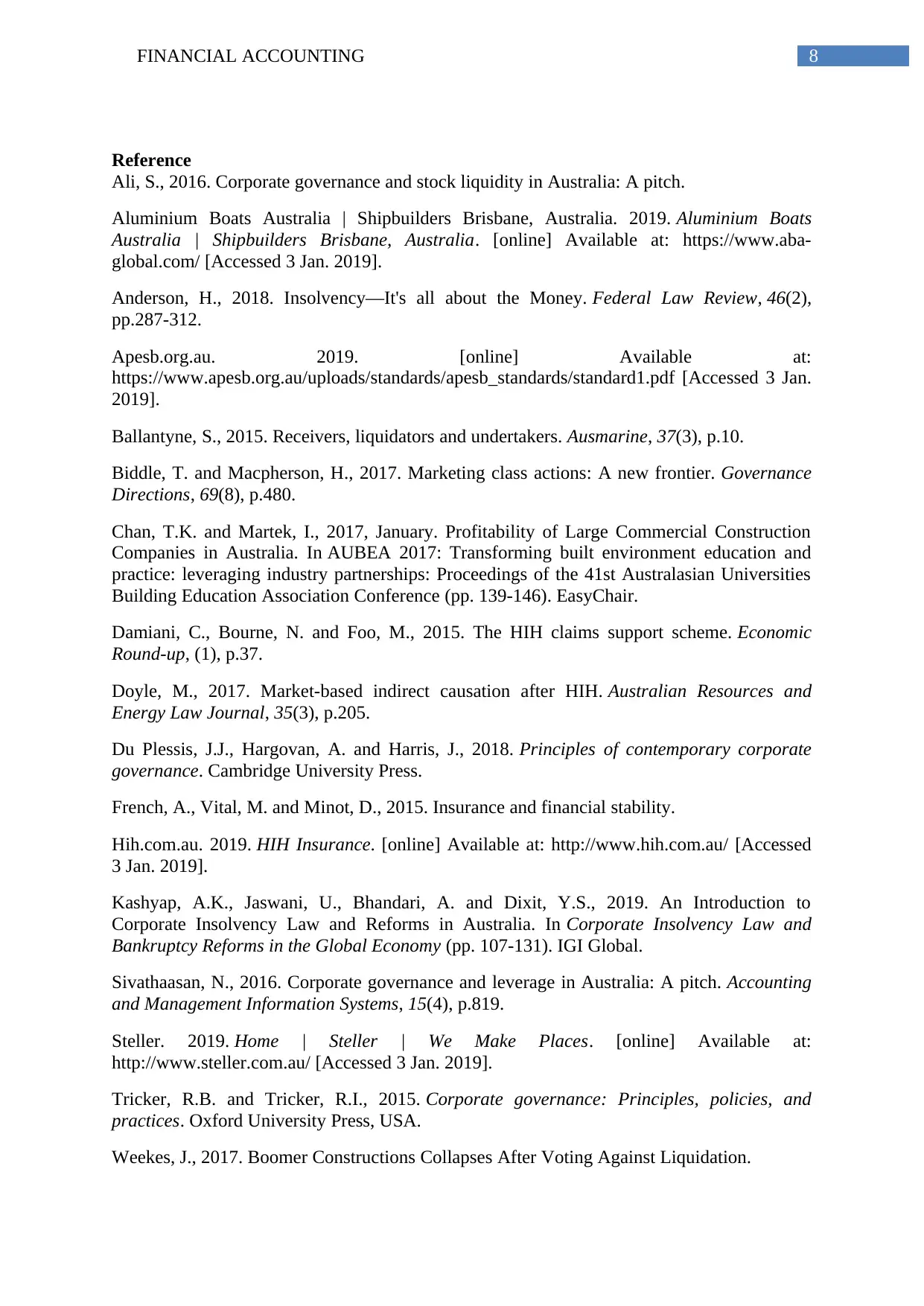
8FINANCIAL ACCOUNTING
Reference
Ali, S., 2016. Corporate governance and stock liquidity in Australia: A pitch.
Aluminium Boats Australia | Shipbuilders Brisbane, Australia. 2019. Aluminium Boats
Australia | Shipbuilders Brisbane, Australia. [online] Available at: https://www.aba-
global.com/ [Accessed 3 Jan. 2019].
Anderson, H., 2018. Insolvency—It's all about the Money. Federal Law Review, 46(2),
pp.287-312.
Apesb.org.au. 2019. [online] Available at:
https://www.apesb.org.au/uploads/standards/apesb_standards/standard1.pdf [Accessed 3 Jan.
2019].
Ballantyne, S., 2015. Receivers, liquidators and undertakers. Ausmarine, 37(3), p.10.
Biddle, T. and Macpherson, H., 2017. Marketing class actions: A new frontier. Governance
Directions, 69(8), p.480.
Chan, T.K. and Martek, I., 2017, January. Profitability of Large Commercial Construction
Companies in Australia. In AUBEA 2017: Transforming built environment education and
practice: leveraging industry partnerships: Proceedings of the 41st Australasian Universities
Building Education Association Conference (pp. 139-146). EasyChair.
Damiani, C., Bourne, N. and Foo, M., 2015. The HIH claims support scheme. Economic
Round-up, (1), p.37.
Doyle, M., 2017. Market-based indirect causation after HIH. Australian Resources and
Energy Law Journal, 35(3), p.205.
Du Plessis, J.J., Hargovan, A. and Harris, J., 2018. Principles of contemporary corporate
governance. Cambridge University Press.
French, A., Vital, M. and Minot, D., 2015. Insurance and financial stability.
Hih.com.au. 2019. HIH Insurance. [online] Available at: http://www.hih.com.au/ [Accessed
3 Jan. 2019].
Kashyap, A.K., Jaswani, U., Bhandari, A. and Dixit, Y.S., 2019. An Introduction to
Corporate Insolvency Law and Reforms in Australia. In Corporate Insolvency Law and
Bankruptcy Reforms in the Global Economy (pp. 107-131). IGI Global.
Sivathaasan, N., 2016. Corporate governance and leverage in Australia: A pitch. Accounting
and Management Information Systems, 15(4), p.819.
Steller. 2019. Home | Steller | We Make Places. [online] Available at:
http://www.steller.com.au/ [Accessed 3 Jan. 2019].
Tricker, R.B. and Tricker, R.I., 2015. Corporate governance: Principles, policies, and
practices. Oxford University Press, USA.
Weekes, J., 2017. Boomer Constructions Collapses After Voting Against Liquidation.
Reference
Ali, S., 2016. Corporate governance and stock liquidity in Australia: A pitch.
Aluminium Boats Australia | Shipbuilders Brisbane, Australia. 2019. Aluminium Boats
Australia | Shipbuilders Brisbane, Australia. [online] Available at: https://www.aba-
global.com/ [Accessed 3 Jan. 2019].
Anderson, H., 2018. Insolvency—It's all about the Money. Federal Law Review, 46(2),
pp.287-312.
Apesb.org.au. 2019. [online] Available at:
https://www.apesb.org.au/uploads/standards/apesb_standards/standard1.pdf [Accessed 3 Jan.
2019].
Ballantyne, S., 2015. Receivers, liquidators and undertakers. Ausmarine, 37(3), p.10.
Biddle, T. and Macpherson, H., 2017. Marketing class actions: A new frontier. Governance
Directions, 69(8), p.480.
Chan, T.K. and Martek, I., 2017, January. Profitability of Large Commercial Construction
Companies in Australia. In AUBEA 2017: Transforming built environment education and
practice: leveraging industry partnerships: Proceedings of the 41st Australasian Universities
Building Education Association Conference (pp. 139-146). EasyChair.
Damiani, C., Bourne, N. and Foo, M., 2015. The HIH claims support scheme. Economic
Round-up, (1), p.37.
Doyle, M., 2017. Market-based indirect causation after HIH. Australian Resources and
Energy Law Journal, 35(3), p.205.
Du Plessis, J.J., Hargovan, A. and Harris, J., 2018. Principles of contemporary corporate
governance. Cambridge University Press.
French, A., Vital, M. and Minot, D., 2015. Insurance and financial stability.
Hih.com.au. 2019. HIH Insurance. [online] Available at: http://www.hih.com.au/ [Accessed
3 Jan. 2019].
Kashyap, A.K., Jaswani, U., Bhandari, A. and Dixit, Y.S., 2019. An Introduction to
Corporate Insolvency Law and Reforms in Australia. In Corporate Insolvency Law and
Bankruptcy Reforms in the Global Economy (pp. 107-131). IGI Global.
Sivathaasan, N., 2016. Corporate governance and leverage in Australia: A pitch. Accounting
and Management Information Systems, 15(4), p.819.
Steller. 2019. Home | Steller | We Make Places. [online] Available at:
http://www.steller.com.au/ [Accessed 3 Jan. 2019].
Tricker, R.B. and Tricker, R.I., 2015. Corporate governance: Principles, policies, and
practices. Oxford University Press, USA.
Weekes, J., 2017. Boomer Constructions Collapses After Voting Against Liquidation.
⊘ This is a preview!⊘
Do you want full access?
Subscribe today to unlock all pages.

Trusted by 1+ million students worldwide
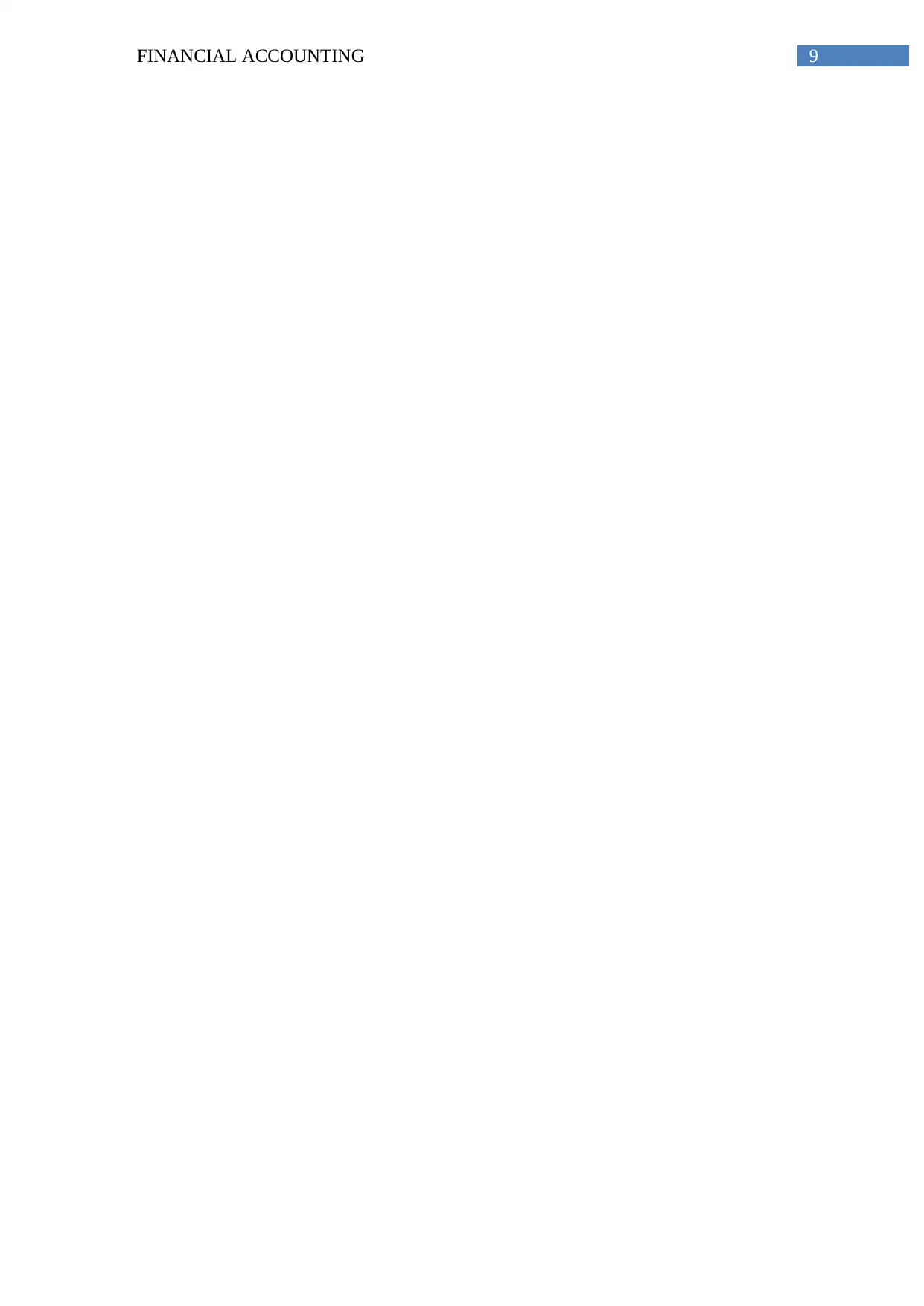
9FINANCIAL ACCOUNTING
1 out of 10
Related Documents
Your All-in-One AI-Powered Toolkit for Academic Success.
+13062052269
info@desklib.com
Available 24*7 on WhatsApp / Email
![[object Object]](/_next/static/media/star-bottom.7253800d.svg)
Unlock your academic potential
Copyright © 2020–2025 A2Z Services. All Rights Reserved. Developed and managed by ZUCOL.




